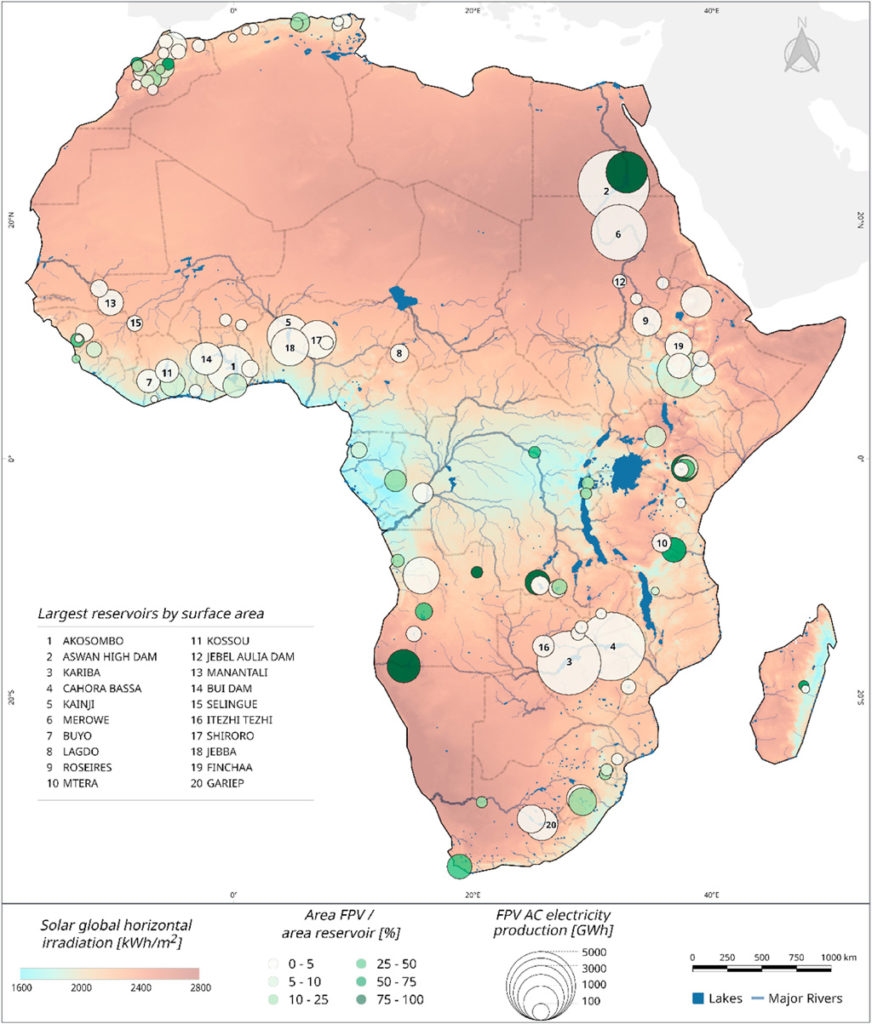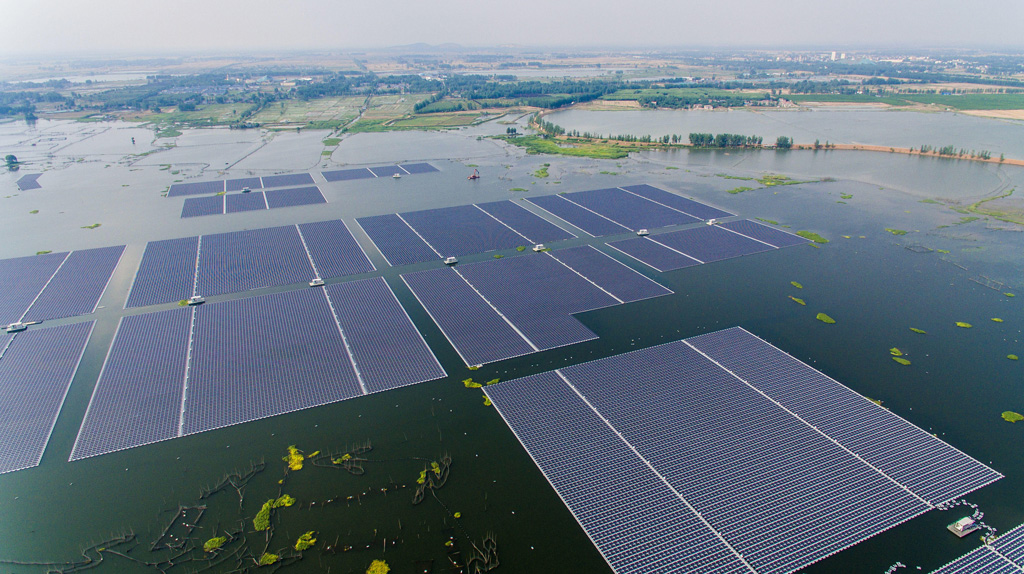
Floating solar panels on 1% of reservoirs ‘could double’ Africa’s hydropower capacity
Josh Gabbatiss
01.29.21Josh Gabbatiss
29.01.2021 | 10:31amSolar panels floating on the lakes formed by Africa’s hydropower dams could be a major new source of power, according to a new study.
If these panels covered just 1% of reservoirs, this alone could double African hydropower capacity and increase electricity generation from dams by 50%.
Hydro dams are the largest renewable power source in a continent where millions of people still lack access to electricity. However, their future potential could be hampered by climate change.
In a new paper published in Renewable Energy, researchers lay out the possibility of using floating solar panels installed on lakes to boost the generating capacity of existing dams.
With the continent caught between “a climate crisis and widespread energy poverty”, one regional expert tells Carbon Brief that floating solar could be a valuable tool to help African nations expand their power infrastructure sustainably.
Boosting hydro
Hydropower accounts for 17% of the electricity generated across Africa and more than 90% in some nations, including Ethiopia, Mozambique and Zambia.
Dr Samuel Gyamfi from the University of Energy and Natural Resources in Ghana, who was not involved in the new study, tells Carbon Brief that African nations have still built far less than other parts of the world:
“This is basically due to financial constraints…Africa has about 90% of its hydro resources yet to be developed for power generation.”
As it stands, less than half the population of sub-Saharan Africa has access to electricity. With more than 50 new dams currently under construction, this technology is often touted as a renewable solution to Africa’s energy needs.
But, with rising global temperatures leading to disrupted rainfall and droughts, existing African facilities are expected to generate less power in the future. On top of this, the dams that have been built have often been linked to social, environmental and political problems.
The new paper proposes floating solar panels as a solution that boosts hydropower capacity using Africa’s “vast solar resources”. Panels can be mounted on floating structures and plugged into existing electricity infrastructure.
The authors* – a team from the European Commission’s Joint Research Centre – tell Carbon Brief:
“Floating photovoltaics could be a potential alternative to expanding hydropower in certain areas, especially in water scarce regions where droughts are causing severe repercussions on hydroelectric generation.”
At the same time, they note that during the wet season hydropower could compensate for the intermittency of solar power in these hybrid systems.
The researchers used a combination of satellite images and data from hydropower reservoirs and solar radiation to estimate floating solar’s potential at the 146 largest hydropower facilities in Africa as of 2016.
In a maximum scenario where 100% of each reservoir was covered with solar panels, there would be an accompanying 100-fold increase in capacity, with 2,922 gigawatts (GW) of solar added to the existing 28GW of hydropower.
This would mean a 50-fold increase in electricity production compared to current hydro output, from 106 terawatt hours (TWh) to 5,293TWh. This dwarfs the total electricity demand across the whole of Africa, which is only around 700TWh.
While covering every reservoir with panels is clearly “not feasible”, the authors note that, even in cases with far less coverage, the gains were substantial.
With just 1% cover, the installed capacity of existing hydropower plants could be more than doubled, rising from 28GW to 58GW.
This would mean increasing the overall electricity output of the hydropower and solar hybrid system to 159TWh, a 50% increase from hydropower alone.
The paper also includes a scenario in which the installed solar exactly matched hydropower capacity, allowing for full use of the dam’s connection to the grid.
This resulted in 0.9% coverage, but only for 108 reservoirs as the remaining 38 required more than 100% coverage to equal hydropower capacity. These reservoirs are shown in the map below, with the size of the circles indicated the size of solar power output.

‘Just solar on a boat’
Though still at the early stages of development, floating solar power has been “growing exponentially”, according to a 2018 report by the World Bank.
Some African nations have taken the first steps towards this new technology, but they are far behind the big players, such as China. A 2019 report found there was 64kW of floating solar deployed in Africa compared to 813,788kW in Asia.
Mohamed Adow, director of Nairobi-based thinktank Power Shift Africa, tells Carbon Brief that diversifying the continent’s energy portfolio with technologies such as floating solar could reduce “outages and overreliance” on hydropower.
Jenny Chase, a solar analyst at BloombergNEF (BNEF) who was not involved in the new study, tells Carbon Brief “sticking solar on hydro plants should be an obvious win”. She adds:
“It’s just solar on a boat. You’ve got the grid connection, so you’re good to go.”
In general, solar power is set for considerable growth in the region, taking advantage of Africa’s ample solar resources and falling prices. “The continent really just needed it to get cheap,” says Chase.
She adds that, while the new study quotes Africa’s total solar capacity as 5GW, according to BNEF figures it was 12.7GW in 2020 and is expected to be 16.7GW by the end of 2021.
An additional benefit provided by floating solar panels on hydropower reservoirs comes from their potential to reduce water loss during periods of drought by forming a shield that blocks any evaporating moisture.
This, in turn, could further boost the power output from the dams. The paper found that using floating panels that fully cover 1% of the water surface would increase hydropower output by 0.17% due to water savings.
“For a continent that will need to cherish every last drop as global heating continues to rise, this is significant,” says Adow.

Costs and challenges
Experts tell Carbon Brief that while the new paper paints an interesting picture, there are issues with floating solar in Africa.
“The technology is excellent, but rather expensive,” says Dr Mmantsae Moche Diale, a solar power researcher at the University of Pretoria.
The study notes evidence from the EU that floating solar power can cost around 20-25% more than the conventional variety.
However, the authors tell Carbon Brief that, with electricity grid infrastructure already in place at hydropower plants, the saving on grid connection costs can make floating solar “more economically viable”.
Chase downplays the additional costs, telling Carbon Brief that “it’s a bit more expensive than ground mount, but not much”, adding:
“Solar’s got so cheap that these days it’s more a ‘why not?’ than ‘why do this’”
Nevertheless, Adow says that to make the scenarios laid out in this paper a reality there will need to be targeted financial support for African governments from richer countries:
“This is why developing nations talk about the importance of ‘technology transfer‘ at the UN climate summits…It must be top of the agenda when countries meet this year at COP26 in Glasgow.”
“Africa is caught between both a climate crisis and widespread energy poverty. Its leaders need to think creatively and be supported,” he adds.
The authors of the new study note that, with floating solar still a relatively new technology, there remain many unknowns, such as the impacts on water quality and technical challenges including the impact of bird fouling and corrosion.
Gyamfi says these issues will vary considerably between countries and notes that more research will be needed to determine how best to scale up floating solar in the region.
The authors say the nations that stand to benefit most from floating solar are northern African countries, as well as South Africa, owing to their relatively low hydropower capacity.
Virtually all of South Africa’s electricity is currently provided by coal, while nations such as Algeria and Libya rely heavily on natural gas.
*The views expressed are purely those of the authors and may not in any circumstances be regarded as stating an official position of the European Commission. The authors are Rocio Gonzalez Sanchez, Ioannis Kougias, Magda Moner-Girona, Fernando Fahl and ArnulfJäger-Waldau.
Gonzalez Sanchez, R. et al. (2021) Assessment of floating solar photovoltaics potential in existing hydropower reservoirs in Africa, Renewable Energy, doi.org/10.1016/j.renene.2021.01.041.
-
Floating solar panels on 1% of reservoirs ‘could double’ Africa’s hydropower capacity
-
Africa’s hydro capacity ‘could double’ with floating solar panels on 1% of reservoirs

